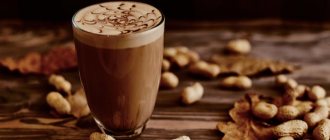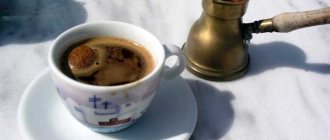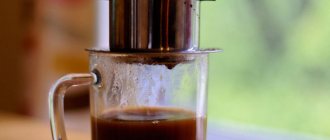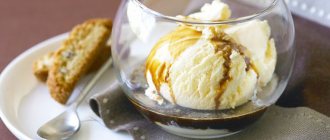Does coffee grow in Greece? Of course not! Then what is Greek coffee and how is it prepared? This is what we propose to talk about today. As they say in one film about Greece: “Everyone should have time for coffee...”. Arriving in Crete, you understand this. Not a single meeting or conversation is complete here without coffee. People drink coffee in Crete at any time: morning, afternoon and even evening... and anywhere. Sometimes you can see a Greek drinking coffee right behind the wheel of a car. But the most popular place where locals meet to discuss the latest events, news, politics, and everyday problems over a cup of coffee is the cafenion. Cafenon is its own philosophy, it is a tradition. The kafenion is often compared to a “men’s club” where local men gather. And coffee plays an important role here...
In any menu on the island of Crete you can find a variety of coffee options, but invariably in the list of any cafe or tavern there is Ο ελληνικός καφές, also known as Greek Coffee, also known as Greek coffee. Frape (Ο καφές φραπέ) is also often found on the menu. Frape is a wonderful drink, original and refreshing, but in this article we will not talk about it, but about Greek coffee.
There are many options for making Greek coffee in various sources. Many of them were personally tried, but the desired result was never achieved. We have often come across statements that either we don’t know how to prepare Greek coffee, or we grind the beans incorrectly. By the way, one of the features of Greek coffee is its very fine grind. The Greeks grind the grains literally to dust. For these purposes, we specially bought a manual coffee grinder that can grind coffee beans to dust. But it’s all in vain, the taste is still not the same. But we did not despair and continued to learn how to make coffee from the Greeks themselves, they shared their secrets with us. And in Crete we were already able to achieve the ideal (well, in our opinion, of course) taste. We came home, everything was wrong again. Yes, as a joke version, the option was proposed that Greek coffee should be prepared in Greece, they say, in that atmosphere of relaxation and serenity, then everything will be fine. But, jokes aside, everything turned out to be much more prosaic. As usual, everything ingenious is simple. Including a Greek coffee recipe. So…
Many of them were personally tried, but the desired result was never achieved. We have often come across statements that either we don’t know how to prepare Greek coffee, or we grind the beans incorrectly. By the way, one of the features of Greek coffee is its very fine grind. The Greeks grind the grains literally to dust. For these purposes, we specially bought a manual coffee grinder that can grind coffee beans to dust. But it’s all in vain, the taste is still not the same. But we did not despair and continued to learn how to make coffee from the Greeks themselves, they shared their secrets with us. And in Crete we were already able to achieve the ideal (well, in our opinion, of course) taste. We came home, everything was wrong again. Yes, as a joke version, the option was proposed that Greek coffee should be prepared in Greece, they say, in that atmosphere of relaxation and serenity, then everything will be fine. But, jokes aside, everything turned out to be much more prosaic. As usual, everything ingenious is simple. Including a Greek coffee recipe. So…
Coffee story
There are legends about the appearance of this natural “energy drink”. The most common of these is associated with the shepherd Kaldim and the events that occurred in Ethiopia in 850. This is how this story sounds according to handwritten sources.
Kaldim drove his herd along picturesque mountain slopes with rich vegetation. Suddenly the shepherd began to notice that, after chewing the leaves of a wild plant, the goats became too vigorous and excited: they began to run, jump furiously, and butt. The young man was frightened and thought that the goats were poisoned, and their inappropriate behavior was a sign of their death throes.
After thinking a little, the shepherd decided to seek advice from the wise monks. He collected several coffee fruits and brought them to the monastery. After listening to the young man’s story, the monks decided that the devil had sent these fruits to earth and they should be burned immediately. The grains were thrown into the fire, and then a rich coffee aroma, hitherto unfamiliar to people, spread throughout the entire monastery.
Judging that such a smell was unlikely to be poison, the beans were quickly pulled out of the fire, crushed and poured with water, thus preparing the world's first coffee drink. The monks liked the black water, and the invigorating properties of the drug helped the ministers tirelessly stay awake during long night services. Later, the popular drink in monastic circles began to be prepared in nearby cities, from where the fame of coffee spread throughout the world.
This is how the legendary legend tells about the appearance of coffee. According to historical information, the Greeks owe the arrival of coffee to the Mediterranean region to the Turks. In Hellas, this drink became widespread precisely during the rule of the Ottoman Empire. The first coffee houses in Greece were Turkish, and their opening dates back to the 16th and 17th centuries. At first, these establishments were visited only by Turks, but gradually representatives of the Greek nation began to be seen here more and more often.
In 1828, with the advent of independence, the first purely Greek coffee shop opened in Nafplion. Here visitors were offered not only to drink a cup of aromatic drink, but also to purchase ground or roasted coffee beans for making homemade Greek coffee. Later, specialized firms and shops appeared in Greece, importing and processing coffee products from different countries. And the drink became more and more popular every year.
Today, Greeks cannot imagine their life without a cup of aromatic coffee. This drink is consumed at every meeting, without paying attention to the time of day or the place of action. Any cafe will offer you several types of coffee drinks, and one of the most popular is the Frappe coffee recipe. This cool cocktail has become one of the symbols of tourist holidays in Greek resorts.
Characteristics
In order to understand what Greek cuisine is, you should dwell on its characteristic features.
- Dishes in Greece are usually prepared exclusively from very fresh products, and the requirements for the quality of ingredients are quite stringent.
- Herbs and spices are present in very significant quantities in Greek dishes. Local cooks use oregano, garlic, dill, bay leaves, basil, cinnamon and cloves, as well as mint and thyme more often than their counterparts from other Mediterranean countries.
- One of the “tricks” of Greek cuisine is a very small amount of salt. An alternative, oddly enough, is lemon. This fruit is added to soups and sauces, and it is served with meat, fish, and vegetables. Greek chefs believe that lemon is much more effective than salt. It helps highlight the taste of the dish and make it more refined.
- Greek yogurt is another local delicacy. It is characterized by high fat content, and due to its dense consistency it is more similar to sour cream. As a rule, it is added to vegetable dishes and is also used to make sauces.
- The “calling card” of Greek cuisine is olive oil. An interesting fact: almost every Greek family, even those living in the city, owns several olive trees, which can grow even tens of kilometers from their owners’ place of residence. Olives, of which more than fifty varieties are known in Greece, are usually harvested from November to January.
- Another “trick” of the local cuisine is the so-called “mezze”. This definition hides a wide selection of light snacks made from vegetables, meat, fish and herbs. They are served before every meal as a separate dish.
- The Greeks are not too keen on sauces. A traditional addition to meat or fish is a mixture of olive oil and vinegar with herbs. Also popular are scrambled eggs with lemon juice and tzatziki, a dish of Greek yogurt, garlic, olive oil, vinegar and cucumber pulp with salt and pepper.
- The main drink in Greece is coffee. They drink it in all forms: cold, hot, with the addition of spices and alcohol.
Greek Coffee Frappe
The history of the appearance of this drink is connected with an incident that occurred in 1957 at a trade fair in Thessaloniki.
The event featured a presentation of new products, and among other companies, the Swiss Nestle participated. The company's Greek manager, Yiannis Dritsas, was to demonstrate a new instant chocolate drink that simply needed to be mixed in a shaker with milk.
During the break, Giannis' subordinate, Dimitrios Vakondios, decided to refresh himself with his favorite instant coffee, but there was no hot water in the pavilion. Then a savvy employee decided to use his company’s method and make coffee in a shaker. By adding dry milk powder and cold water to the instant powder, and shaking all the ingredients in a shaker, Dimitrios got a cool cocktail, which later became known as Greek coffee called Frappe.
By the way, the expression frappe was borrowed from the French language, where it means “chilled with crushed ice.” The name is telling, because... In addition to cold water, pieces of ice must be added to the original Frappe recipe.
Since its opening, this drink has gained incredible popularity and has become the hallmark of Greece. The cocktail recipe is quite simple, so it is made and served in cafes and restaurants all over the world. But real Greek Frappe has its own inimitable features. This coffee not only pleasantly cools and pleases with its rich taste, but also tones the body.
Origin
The frappe cocktail appeared relatively recently. It was first prepared by Dimitrios Vakondios, who worked at one of the Nestle fair stands. The recipe was invented due to a coincidence.
One summer day in 1957 the weather was very hot. Dimitros wanted to drink a portion of his favorite coffee drink, but he didn’t have boiling water on hand. But there was a shaker available. The guy just decided to mix sugar, coffee and cold water in it. He also added a few ice cubes to the shaker.
The result of such actions was pleasantly surprising. The Greek managed to prepare an invigorating and refreshing cold drink with a fairly strong taste. Besides, he looked attractive. While beating, a high foam formed.
Greek Frappe Recipes
As already noted, there are many ways to prepare Greek coffee. Basically, they differ not so much in methodology as in composition: coffee with milk, coffee with chocolate, coffee with ice cream, etc. In this section we will look at how to prepare classic Frappe coffee (Greek style) and several recipes with different variations of ingredients.
Classic Frappe
The drink, which came to us from sunny Hellas, is very simple to make. You need to take instant coffee (1-2 tsp), 150 ml of cold water, ice cubes and sugar to taste. Mix all ingredients in a shaker until foamy (but reserve some ice for decoration). Pour the resulting mixture into a glass, add ice and enjoy the refreshing taste of coffee.
Frappe with milk
To give the taste softness and tenderness, a little milk or cream was added to the cocktail. These delicious homemade Greek recipes require a little more prep time, but the rich flavor is worth it.
First you need to brew 50 ml of coffee and add a teaspoon of sugar. Then cool the prepared drink, then add cold water (40 ml) and milk (40 ml) to it. Beat the mixture until foamy. Add crushed ice to the prepared cocktail and serve.
Frappe with ice cream
If you like sweet coffee, then you will like this recipe.
How to submit correctly
Iced coffee frappe is a cocktail. That's why it is served in a tall glass. As a rule, transparent dishes are used. Due to this, it is possible to emphasize the unusual layered structure of the drink.
It is customary to drink frappe through a straw. If it is prepared with the addition of berries or fruits, an additional dessert spoon is served. The drink is poured into pre-chilled glasses.
This cocktail goes perfectly with a variety of sweets. You can serve it with panna cotta, tiramisu and other desserts. Pastille and marshmallows can highlight its refined taste.
The decoration of the drink deserves special attention. For this purpose, fruits, berries, mint leaves and ice are often used.
Frappe is an amazing cocktail with an extraordinary, refined taste. A big plus is the ease of preparation. The main advantage of this drink is the abundance of recipes. Almost the same ingredients can be used to prepare a new cocktail every time.
- 12.06.19 17:00
- 13563
One of the most popular summer drinks in Greece is without a doubt iced coffee. In Greece, people most often drink frappe and fredo (fredo cappuccino - fredo espresso).
FRAPPE
Greek frappe recipe
- Pour about water into a tall glass onto your finger.
- Add 1 spoon of instant coffee and sugar to taste.
- Beat the mixture in any convenient way - there are special mixers, you can use a shaker, or you can do it as in the video below if you don’t have anything on hand!
- When fluffy foam rises, add ice, milk and cold water to taste. Your frappe is ready!
How to drink frappe
Frappe categories are approximately the same as those of Greek coffee - sketos, metrios, glycos . That is, black, medium sweet and sweet. Some people add milk, some don’t, it’s a matter of taste. Of course, people drink frappe not only in the summer, but all year round.
The word frappe is of French origin, meaning “whipped, mixed.” But for the French, frappe is usually a cold cocktail with milk, ice cream or fruit. Greek frappe is sometimes also served with ice cream, at the client's request. The Greeks remade the French word for themselves, and frappe in Greek is called ο φραπές - a masculine word, by analogy with the word “ο καφές” - coffee.
How to order frappe
It is very easy to order a frappe in a cafe. Here are a few phrases that may be useful to you:
- Ενα φραπέ σκέτο, παρακαλώ [Ena frapE skEto, parakalo] - One black frappe, please (without everything)
- If you want a frappe without sugar, but with milk, say
- Ενα φραπέ σκέτο με γάλα, παρακαλώ [Ena frapE sketo me gala, parakalo]
- Ενα φραπέ μέτριο (γλυκό) με γάλα (χωρίς γάλα) [Ena frapE mEtrio (glyco) me gala (horis gala)] - Frappe medium (sweet) with milk (without milk)
- Ενα φραπέ παγωτό, παρακαλώ [Ena frapE pagoto paracalo] Frappe with ice cream, please
While drinking coffee, you can add cold water to the coffee, and at the end, most frappe lovers suck out the delicious foam with noisy pleasure. It remains to add that instant coffee is no different in its usefulness and you should not drink frappe fanatically. One a day is enough, then think for yourself, take pity on your precious body! But in hot weather, frappe can really invigorate and refresh!
FREDO
Fredo is a popular drink in Greece. It can be prepared even at home, without using a coffee machine or other devices. There are many variations of the recipe, but traditionally 4 main ingredients are used:
- Coffee, espresso mixture;
- Milk;
- Crushed ice;
- Syrup for coffee.
Fredo coffee is a drink with a rich taste, which is also an excellent digestif, that is, it has a positive effect on digestion, and is especially recommended to drink after a hearty lunch. Iced coffee is more invigorating than hot espresso.
Fredo coffee recipe
Beans: Use any espresso blend. If it is 100% Arabica, let it be medium roasted; if the roast is strong, it is better to choose a blend with the addition of 20-30% Robusta, which will increase the caffeine content.
- Brazilian Arabica is sweetish and gives body to the drink.
- African Arabica – with a slight sourness, wine and berry flavor.
- Arabica from Central America is slightly sour, with notes of citrus.
- Indonesian Arabica is more piquant and makes the taste of coffee more interesting.
Water: it is better to take purified water, it better reveals the taste of coffee, makes it bright and full.
Milk: optimal fat content 1.5 – 1.8%;
Ice: It is advisable to crush it in a blender immediately before cooking, although if you don’t have a blender, ice cubes will do.
Syrup: caramel syrup is standard, chocolate or vanilla is acceptable, fruit syrup is undesirable, as the milk may curdle.
Brew double espresso in a Turk or any type of coffee machine. If you cook in a Turk, you will need to strain it so that you get 60 milliliters. Pour the espresso into a shaker or similar lidded container, add 50-70 ml milk, 15 ml syrup and 4 crushed ice cubes. Shake several times to create foam.
Tip: If you don’t have a blender, shake the coffee with ice cubes, or put the cubes in a glass and pour the shaken mixture of coffee, milk and syrup over it.
You can add sugar, cinnamon, chocolate chips, whipped cream or whipped milk on top. With whipped milk foam you get a Fredo cappuccino.
The cocktail can also be alcoholic if you add a teaspoon of liqueur.
What and with what to serve Fredo coffee
- Traditional serving option: strain the mixture from a shaker into a glass; if there is a lot of foam, spoon it on top.
- Alternative: pour out of shaker along with crushed ice.
The Fredo coffee glass is a universal cocktail highball glass with thick walls and a capacity of 270 ml. Coffee is drunk from a thick straw.
Calories in Fredo coffee
A standard serving contains approximately 80 kcal based on: 2 kcal in coffee, 25 in 1.5% fat milk, 55 kcal in syrup. If you add a teaspoon of sugar, you will add about 25 more kcal. If you take fattier milk, the total calorie content will become even higher. There are special low-calorie syrups (about 4-5 kcal for a cup of coffee), but they are usually not used in cafes. Additives and toppings (whipped cream, chocolate, etc.) also increase the calorie content of the fredo.
Fredo coffee: price and where to order
Not all coffee shops serve Fredo, so you have to try hard to find one that serves it right. In Moscow and St. Petersburg, a glass of Fredo coffee (with variations of Fredo cappuccino, Fredo mocha) costs about 250-300 rubles. In the regions, they will more often offer the usual iced coffee, or an alternative fredo (ice cubes filled with espresso with milk and syrup). In Europe, fredo costs 2-5 euros, depending on the establishment, but it is also prepared on every corner (especially in Italy and Greece).
Conclusion
- Fredo is not a very strong coffee due to the added milk and ice.
- It has good tonic properties, invigorates and cools.
- You can even cook it at home.
- Slightly sweet taste due to the added syrup.
Have you tried Fredo coffee yet? Which establishments cook it tastier?
Read Russian Athens in —>
Share link:
About how to share Commenting Rules (comments are pre-moderated)
Hello, dear readers! The next most popular Greek coffee is frappe, a cold drink whipped with fluffy foam, with the addition of ice, milk and sugar to taste. We talked about traditional boiled Greek coffee in the previous article, and now you will learn about how to prepare frappe and how it came to be. At the end - a small lesson in Greek.
Traditional Greek coffee
In addition to Frappe, people in Greece also like to prepare other types of coffee drinks. And here the palm undoubtedly belongs to the famous Greek coffee.
“I love natural coffee,” is a phrase you can often hear from a Greek. Residents of sunny Greece are accustomed to not wasting speed at the expense of quality. Therefore, to properly prepare Greek coffee, many nuances should be taken into account.
Which variety is better: Arabica or Robusta
For the Greeks, not only the technique is important, but also the initial qualities of the product. The type of coffee determines the taste and aroma of the finished drink. To prepare a Greek coffee recipe, it is best to use a mixture of Arabica and Robusta varieties.
Is it possible to replace ground coffee with instant coffee?
Instant coffee varieties are used in Greece to make the cold coffee drink Frappe. Greek brewed coffee is always just coffee made from ground beans. There are no exceptions to this rule.
The secret of cooking
There are a large number of methods for brewing coffee, and each of them has its own advantages.
Greek cold Frappe is a coffee valued for its quick and easy preparation. With traditional Greek coffee, things are completely different. The Greeks simmer the ground grains on the stove very slowly; they practically do not even cook them, but bake them. And in the drink recipe, it is necessary to maintain exact proportions so as not to disturb the ideal taste combination.
Greek coffee is prepared only from ground beans and always in a Turk with a narrow neck. Pour water into the bowl and bring to a boil. Then add 2 tablespoons of coffee and a spoonful of sugar, and then put it back on the fire. Brew the drink until thick foam forms, observing certain nuances.
In order to reproduce the traditional Greek method of brewing coffee, you need to place the Turk on a flame divider. In the absence of the latter, you can use a complicated, but more convenient method. Place a frying pan with sand (layer 2-3 cm) over low heat. As soon as the sand warms up, we place the Turk directly on it and brew our Greek coffee. During the brewing process, the drink must be stirred constantly.
Thick Greek Kaimaki
Foam deserves special attention. Greek coffee always contains large air bubbles in the cup, which appear from heating the coffee oil. This effect is called "Kaymaki". It is very interesting that this phenomenon even has its own local legend about matchmaking. If a girl doesn’t like the groom, she will present him with coffee without foam, and the gentleman who likes her is always treated to coffee from kaymaki.
To prepare such foam, you need to know the secret of the local coffee ritual. And it lies in the fact that the drink should never be brought to a boil. As soon as the coffee is ready, the Turk is removed from the stove, and after a couple of seconds they are put back. To obtain thick foam, this trick must be done several times.
It is worth noting that coffee from kaymaki is not finished until the end, because... There is a thick residue left at the bottom.
With thick foam
To make a fragrant drink with thick foam, you need the following ingredients:
- 1 teaspoon ground coffee;
- sugar in the amount of one teaspoon;
- 70 ml cold water.
First, water is poured into the Turk. Then sugar and coffee are added. The indicated ingredients are thoroughly mixed. The dishes are placed on low heat. As soon as a thick foam appears, the Turk needs to be removed from the heat. The foam is poured into a cup. After which the Turk is again placed on the fire. Then the resulting foam is carefully removed again. The Turka is put back on the fire. After thick foam appears in the container again, the hot coffee is poured into a cup: it is one hundred percent ready for drinking.
In conclusion, it must be emphasized that there are a huge number of options for making coffee. But in order to make it truly tasty, it is recommended to use very finely ground grains, crushed practically to the point of dust.
Greek coffee and Frappe drink: recipes and production secret.
Despite the fact that in European countries this invigorating drink began to be consumed only a couple of centuries ago, traditional coffee has managed to be enriched with hundreds of different types and production methods. At home there is Greek coffee, the real taste of which can only be discovered when traveling to Hellas. Greece is the land of true connoisseurs of coffee pleasure: it is not for nothing that the Greeks have a widespread saying that good coffee is remembered for as long as 40 years. What is the secret of local recipes? We'll find out in this article.











